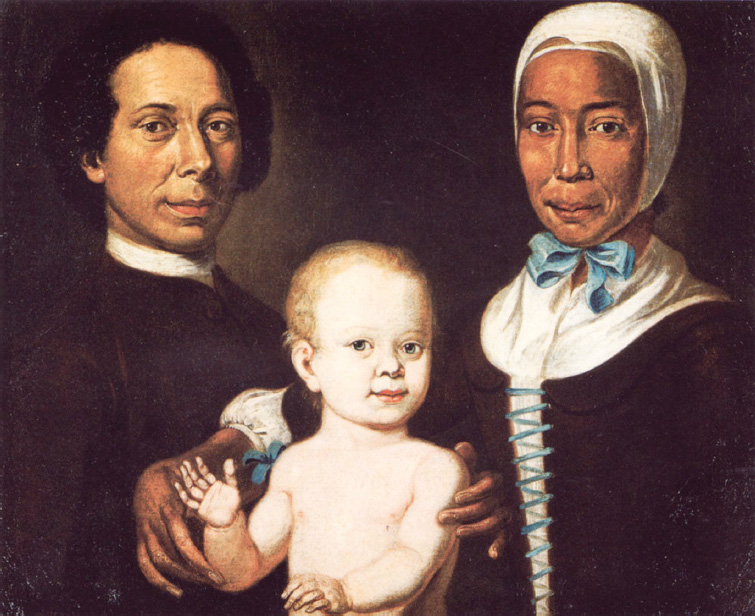A History of Western Society: Printed Page 568
A History of Western Society, Value Edition: Printed Page 578
INDIVIDUALS IN SOCIETY
Rebecca Protten
 | ONLINE DOCUMENT ASSIGNMENT |
| What does Rebecca Protten’s story reveal about the complex relationship among slavery, race, and religion in the eighteenth century? Examine primary sources concerning these interconnected issues, and then complete a writing assignment based on the evidence and details from this chapter. |
In the mid-1720s a young English-speaking girl who came to be known as Rebecca traveled by ship from Antigua to the small Danish sugar colony of St. Thomas, today part of the U.S. Virgin Islands. Eighty-five percent of St. Thomas’s four thousand inhabitants were of African descent, almost all enslaved. Sugar plantations demanded backbreaking work, and slave owners used extremely brutal methods to maintain control, including amputations and beheadings for runaways.
Surviving documents refer to Rebecca as a “mulatto,” indicating a mixed European and African ancestry. A wealthy Dutch-speaking planter named van Beverhout purchased the girl for his household staff, sparing her a position in the grueling and deadly sugar fields. Rebecca won the family’s favor, and they taught her to read, write, and speak Dutch. They also shared with her their Protestant faith and took the unusual step of freeing her.
As a free woman, she continued to work as a servant for the van Beverhouts and to study the Bible and spread its message of spiritual freedom. In 1736 she met some missionaries for the Moravian Church, a German-Protestant sect that emphasized emotion and communal worship and devoted its mission work to the enslaved peoples of the Caribbean. The missionaries were struck by Rebecca’s piety and her potential to assist their work. As one wrote: “She researches diligently in the Scriptures, loves the Savior, and does much good for other Negro women because she does not simply walk alone with her good ways but instructs them in the Scriptures as well.” A letter Rebecca sent to Moravian women in Germany declared: “Oh how good is the Lord. My heart melts when I think of it. His name is wonderful. Oh! Help me to praise him, who has pulled me out of the darkness. I will take up his cross with all my heart and follow the example of his poor life.”*
Rebecca soon took charge of the Moravians’ female missionary work. Every Sunday and every evening after work, she would walk for miles to lead meetings with enslaved and free black women. The meetings consisted of reading and writing lessons, prayers, hymns, a sermon, and individual discussions in which she encouraged her new sisters in their spiritual growth.

In 1738 Rebecca married a German Moravian missionary, Matthaus Freundlich, a rare but not illegal case of mixed marriage. The same year, her husband bought a plantation, with slaves, to serve as the headquarters of their mission work. The Moravians — and presumably Rebecca herself — wished to spread Christian faith among slaves and improve their treatment, but did not oppose the institution of slavery itself.
Authorities nonetheless feared that baptized and literate slaves would agitate for freedom, and they imprisoned Rebecca and Matthaus and tried to shut down the mission. Only the unexpected arrival on St. Thomas of German aristocrat and Moravian leader Count Zinzendorf saved the couple. Exhausted by their ordeal, they left for Germany in 1741 accompanied by their small daughter, but both father and daughter died soon after their arrival.
In Marienborn, a German center of the Moravian faith, Rebecca encountered other black Moravians, who lived in equality alongside their European brethren. In 1746 she married another missionary, Christian Jacob Protten, son of a Danish sailor and, on his mother’s side, grandson of a West African king. She and another female missionary from St. Thomas were ordained as deaconesses, probably making them the first women of color to be ordained in the Western Christian Church.
In 1763 Rebecca and her husband set out for her husband’s birthplace, the Danish slave fort at Christiansborg (in what is now Accra, Ghana) to establish a school for mixed-race children. Her husband died in 1769, leaving Rebecca a widow once more. After declining the offer of passage back to the West Indies in 1776, she died in obscurity near Christiansborg in 1780.
*Quotations from Jon F. Sensbach, Rebecca’s Revival: Creating Black Christianity in the Atlantic World (Cambridge, Mass.: Harvard University Press, 2006), pp. 61, 63.
QUESTIONS FOR ANALYSIS
Question
Why did Moravian missionaries assign such an important leadership role to Rebecca? What particular attributes did she offer?
Question
Why did Moravians, including Rebecca, accept the institution of slavery instead of fighting to end it?
Question
What does Rebecca’s story teach us about the Atlantic world of the mid-eighteenth century?